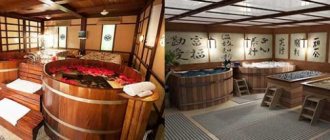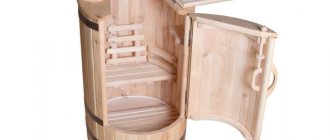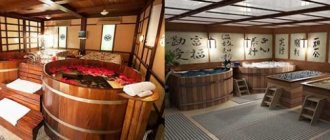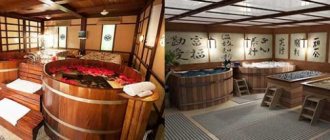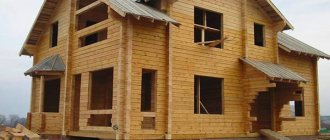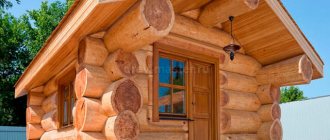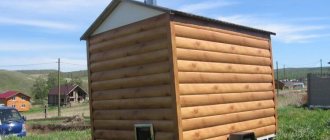It so happened historically that in the baths of all nations of the world, in addition to the function of washing a person clean, there is another one - health. Only health issues are resolved in different ways. In a Finnish sauna, this is an extremely high temperature with a sharp cooling after the steam room. In a Russian bath - extreme treatment with brooms with hot wet steam, in a Turkish hammam - the presence of a massage therapist in the steam room with his, sometimes, very hard massage. But no less interesting is the Japanese bathhouse-furako 日本. Sometimes, based on the name of the second part of the procedures in such a bath, it is called otherwise – bath-ofuro お風呂, where the first お “o” in the hiragana syllabary is simply a politeness prefix.
Let's look at what the difference is below.
Now in our Far East, local entrepreneurs dealing with the business of their geographical neighbors have built such establishments in the Primorsky and Khabarovsk Territories, and are increasingly trying to resolve issues with their Japanese colleagues in them. By introducing the Russian tradition of such solutions into the Japanese ritual of bath-furako.
What it looks like and what it is structurally
A public (or for a large family) Japanese bathhouse looks like a large, low, wooden round pool. But essentially, it's a tub. Even the techniques for creating it go back to the art of coopers: the same rivets made of oak, cedar or some exotic wood, the same hoops that tighten the structure. Only along the inner perimeter are there benches, rigidly attached to the sides along the entire circumference, designed for average human height. They also play the role of an internal frame, and are of considerable importance in the entire bath procedure.
In the case of creating an individual Japanese bath-ofuro, which is a large barrel for one person, and there is only one bench for sitting in it.
Fun fact:
| The first furako bathhouses in Primorye copied Japanese designs only conceptually, while the height of both the sides and benches was made to suit the average height of a Russian person. What caused confusion when guests from the Land of the Rising Sun were invited to such a bathhouse with the intention of showing respect. The Japanese, for the most part shorter than us, had to sit in the pool up to their necks in water - whereas according to the rules the water should only reach the middle of the chest. They apologized to the guests for a long time, in the spirit of the rules of politeness accepted in Japan. The water from the pool was drained, and the carpenter who was called quickly built removable attachments and extensions. |
Later, our hospitable entrepreneurs moved on to creating individual barrel baths, designed for one person - but located in a circle so that one could communicate while taking such a bath. And hygiene issues were resolved more easily in such an individualized ofuro bath. But nothing came of this, since it went against the very essence of such a philosophy ofuro, which requires introspection and maximum detachment from the problems of the world. So, in such baths in Russia, they either do not “resolve issues” with Japanese partners, or they do, but only within their own circle. Which, in general, is already a profanation of the very essence of this kind of Japanese establishment.
Wood selection
Plywood and chipboard cannot be used for the box. There must be a high-quality array. Not just any tree will do. The Japanese ofuro bathtub is never made of pine. This is a coniferous tree; when heated, the wood “cries” with resin.
Coniferous species used for Japanese baths are larch and cedar. Larch is a tree that is resistant to dampness and temperature changes. Cedar is considered a healing tree. When heated, it smells pleasant and releases phytoncides. Dense and durable oak wood is suitable for the box.
In Russia, manufacturers of Japanese baths used linden. Its wood is soft and, when heated, emits a delicate aroma. Furaco baths made from linden are ordered for herbal medicine.
Box parameters
| Width | 800 – 1000 mm |
| Length | 2000 mm |
| Height | 800 –1100 mm |
The wall thickness is 4.5-5 cm. The dies are placed vertically. A dovetail connection is used. At the head there is a semicircular elevation. Several steps are needed to enter the box.
Now electric heaters are installed to heat sawdust and stone. They are built into the bottom of the box. Once upon a time, the Japanese ofuro was heated by a wood stove. But there is no information about its device.
The amount of sawdust for a standard single ofuro box is 45-50 kg. To replace wet sawdust after one procedure, 2-3 kg are required.
Sawdust is made from types of wood:
You can take sawdust from birch, fruit trees, and cypress. The sawdust is prepared for use. They are impregnated with aromatic oils. Mix with dry herbs.
Important. Recipes for herbal infusions for the treatment of various diseases were developed by P. Losevskaya. These are dry mixtures of herbs for steaming in a phyto-barrel, teas, balms and oils for massage. All plants are collected in the Urals, Altai and Siberia. Herbalists recommend Japanese baths with these drugs.
Water temperature and how it is maintained
The water temperature is maintained at 42-45 degrees, that is, it feels 6-9⁰C higher than the temperature of the human body and such water is perceived as quite hot, but tolerable. It’s no longer possible to sit above chest level—you won’t be able to sit for long. And the requirement to sit in water so that its level is no higher than the middle of the chest is associated with the rhythm and strength of the heart when the body is heated: as soon as you dive 5 cm deeper, the heartbeat quickens, breathing becomes more difficult, and about some It’s already difficult to talk about the comfort and even the benefits of bath procedures.
The water is heated by a wood-burning or electric stove, which is structurally integral with the tub. The stove can be brick, stone or cast iron; in Japan there is an entire metallurgical production dedicated only to the production of special fireboxes for furako baths. Although, if the pool is of non-standard size or shape, craftsmen often prefer stone or brickwork, which is easier to adjust to the size of the tub.
Ofuro font with stones
After the procedure with sawdust, you must take a session with heated stones. To begin with, they are laid on their stomach. To avoid getting burned on them, they are covered with a sheet. Heated stones are also placed on the back along the spine, but of a larger size, so that they do not cool down quickly.
The procedure is then repeated after turning over. While in such a stone bath, a light massage is performed. Thus, the muscles of the body not only warm up and the tension goes away.
Furaco side material
No matter what kind of wood the sides of this pool (or an individual barrel) are made from, the cells of the tree for a very long time, for years, release all sorts of aromatic and tanning substances into the water, which affect the general condition of a person with their microdoses (which is the meaning of a wooden barrel). The most expensive furaco baths of this kind are, naturally, created from valuable and rare types of wood: boxwood, myrtle, sakura, laurel. Sometimes the source material, tree trunks, is so miniature that a set of pool sides is made up of several thousand boards - and this is with a tub diameter of only 5-6 meters. Great skill is required so that the set does not crumble inward due to the pressure of the rivets, either swelling from water or drying out without it, wood. This is also why the sides of the tub are constantly kept wet - even when the volume of the pool is not used for its intended purpose.
Basics of Japanese bath traditions
So, a bath in Japan is something different compared to everyone’s favorite steam rooms, stones poured with water, and birch brooms. To some extent, these are large bathrooms. At the same time, the healing and rejuvenating effect on the skin is no worse than in traditional Russian baths.
Today, the Japanese bath comes in three types:
- furaco;
- ofuro;
- sento.
The first two types involve individual use at home, or are used for visiting by 1-2 people at the same time. Sento baths are public baths that can accommodate more than 100 people at a time.
Regardless of what the Japanese bathhouse is called, what size it is or what it looks like, the philosophy and meaning of such establishments are the same. The therapeutic effect on the skin is not heated and humid air, but hot water or sawdust (in some cases, pebbles). Actually, the filler was selected precisely on the principle that it should accumulate heat well and warm the human body.
Procedures and paraphernalia
Not a single bathhouse in the world is complete without certain rituals, and the Japanese one is no exception. Only if in a Russian bathhouse, drinking tea or drinking beer after all the procedures is not very necessary, then in a full-fledged Japanese bathhouse, with all the procedures, a whole ritual has been maintained for centuries, breaking which is the height of indecency. And the Japanese are very sensitive to such things as “decent or indecent”.
View this publication on Instagram
Publication from Andrey Chernov (@bigcupel)
Step one - foot massage
The first thing a person does when he comes to a furaco bathhouse is wash his feet and expose his feet to a massage. Why is there a special person in the furaco baths? This procedure is very important, not a single Japanese neglects it, since he knows the basics of oriental medicine, and they tell him that there are points on the feet that are responsible for the vital functions of the entire body. So if a person has certain health problems, then a minister will help him with this (although in fact it is a minister). Pressing certain points on the foot sets you up for relaxation and properly relaxes you.
Step two
Before diving into the furaco pool, the visitor takes a shower. For staying in moderately hot water, sitting on a bench and inhaling the aroma of cedar or myrtle, is not a simple washing process, but a whole philosophy. So the cleanliness of the body is ensured in advance, especially when visiting a public bathhouse, where up to one and a half dozen people can sit in a tub - as long as the circumference of the walls and the distance between the benches for sitting, the interval between which is at least 1 meter, is sufficient. For the same reason, you cannot sit in a furaco vat lounging with your hands on the side - this way you will inevitably touch your neighbor, and this is not accepted.
Relax
Before bath procedures, a person tunes in to them, putting himself into a state of some kind of trance on relaxation couches located in a circle along the walls of the room where the pool is located. And only after that he plunges into the water, where he sits quietly, not disturbing anyone, and thinking about the eternal. The brave hoot with which our people burst into the steam room of a Russian bathhouse is not accepted here and will at least cause bewilderment.
Staying in the bath
In addition to general warming up of the body in water, a person simultaneously takes phytoprocedures from those volatile aromatic substances that are released from the wood of the boards. Naturally, over the years the yield of such substances decreases, so bath masters always have aromatic essential oils or extracts of certain plants at the ready: fir, roses, myrtle, linden, etc. Literally two drops on a surface of water with an area of 20-25 sq. meters turns out to be enough to aromatize the air for 10-15 minutes - and this is exactly how long the process of sitting in the pool and aromatic relaxation lasts. If you sit longer, it will be harmful to your health.
Relax-2
After leaving the pool, the visitor wraps himself in a linen or cotton sheet and lies down on a couch, where he remains until the body is completely dry. Breathing should be calm, rhythmic; you cannot be distracted by anything at this moment. This, by the way, is facilitated by the Japanese culture of communication between people, where the principle of personal space and respect for the comfort of others is sacredly observed. A person can behave as he pleases in society outside of some community to which he belongs or does not belong at a given moment in time, but if he has entered such a community, uniform rules of interaction begin to apply. And a visit to the public bathhouse, traditional for Japan, Furako, is just an example of joining such a temporary community.
Step six – “dry bath”
There is no analogue to this procedure in any bathhouse in the world. And actually the term “furako” itself refers to this part of the ofuro bath procedure. It’s a stretch to compare it to whipping the body with bath brooms knitted from branches of different tree species. At least in terms of phyto-impact, these procedures are similar. But in terms of physical essence... In general, a person who has completely washed himself and gone through a procedure of self-contemplation followed by resting on a couch lies down in a bathtub filled with hot dry sawdust from different types of trees, although usually it is cedar, to which the Japanese have a special relationship. Sometimes specially dried herbs are added to sawdust. The effect of sawdust and herbs heated to 45-50 degrees on the body resembles an aromatic steam room: profuse sweating begins, and phytoncides released from sawdust and shavings actively affect both the skin and the respiratory system. The sweat released by the skin is actively absorbed by dry sawdust. And then it evaporates, making them suitable for use with other people. The procedure is not suitable for everyone. People with heart disease may have problems with the load on it, and a possible allergic reaction to certain aromatic (albeit natural) substances released from the cells of wood and herbs may also occur. In addition, the procedure itself is expensive. But for residents of the coastal part of Japan, where colds are a frequent visitor, such heating with sawdust or stones will be very useful - even if only for a short time.
After the woody dry bath, a second wash in the shower follows, and the person moves on to the next dry bath, this time filled with small pebbles or crushed stone. This bath is even hotter, up to 60 degrees. The visitor lies on his stomach, and individual stones can be laid out along his spine, on the sacrum, on the shoulders or neck in a certain order. At the same time, the bath attendant gives the person a light massage with her fingertips.
Tea ceremony
The last thing that awaits a visitor to such a bathhouse is a room for tea ceremonies. It is served by specially trained attendants, and the teas served are also traditionally Japanese. Firstly, the tea is purely green, often not fermented. Secondly, some kind of floral or berry addition is required: jasmine, juniper, collected and dried sakura sepals, rose or chrysanthemum petals, hop cones or something else. In old ofuro baths, one or two types of tea additives are usually chosen and these traditions do not change. Green tea completely stops the dehydration process, that is, sweating stops, and the body's cells begin to work to restore fluid balance, carrying out membrane ion exchange.
All bath procedures are also traditionally carried out by specially trained geisha girls who can carry on a conversation on any topic, give a light massage here, and there will be no sexual overtones in their actions: the furako bath is not an establishment where visitors are looking for pleasure of such kind. And the word “geisha” (geisha, 芸者, in traditional Japanese hieroglyphic writing) just means “person of art.” And the precise execution of all ceremonies, not just the tea room, in the furako (ofura) bathhouse is a high art.
In the first stage of training in client care procedures, the girl's position is called maiko (舞妓). The next step, something like an experienced apprentice, is geiko 芸伎. And only then the girl, having mastered all the intricacies of bath procedures and ceremonies, becomes a full-fledged and very highly paid geisha.
Varieties
Conventionally, there are 3 types of Japanese baths: furako, ofuro and sento. In fact, everything looks different. This classification can only be understood after a more thorough study of each type.
Furaco
The Japanese bathhouse furako involves a voluminous round or oval wooden container in which the procedures take place. A mandatory attribute of the barrel is a heating element. In home versions it is an electric (or more economical gas) heater, in outdoor ones it is a wood heater.
Interesting! In traditional Japanese baths, the water was always heated with wood.
Inside the container is divided into 2 parts. One is for bathing, the second contains a heating device. There are designs in which the heater is located outside the container. The “font” is equipped with a bench and can accommodate from 1 to 10 people, depending on the size.
Water is heated evenly and can reach 55 degrees or more. For maximum effectiveness of healing properties, herbal infusions, aromatic oils, and flower petals are added to it. Please note that the barrel of a Japanese bath should be made of natural wood; the use of other “dead” materials will not have such healing properties on the body.
The advantages of the Japanese furako bath are as follows:
- Removing waste and toxins released as a result of excessive sweating.
- Stimulation of metabolic processes and immunity.
- Improving skin condition, opening and cleaning pores.
- Normalization of the activity of the heart muscle and blood vessels.
- Prevention and therapy of the genitourinary, nervous systems, musculoskeletal system, respiratory organs.
Healthy! When arranging a furaco bathhouse in the garden, it is advisable to provide a lid. This will prevent foreign debris, dust, and leaves from entering during its downtime.
Ofuro
Healthy! Ofuro bath is called the best natural procedure for rejuvenation and weight loss.
In most cases, it is made in the form of a rectangular wooden box with a side height of 50-60 cm. Ash, cedar or oak are used as materials for assembly. The lower part is equipped with a heating system with a thermostat.
A kind of font is filled with sawdust and shavings, into which a person immerses. To increase the healing effect, medicinal herbs, aromatic oils, roots, and essential oils are added. The composition is heated to a temperature of 45-55°C.
During the procedures of the Japanese bath ofuro, a person is immersed in the mixture and stays inside for 10-30 minutes. During this time, the process of accelerated sweating begins, when increased release of toxins and salts absorbed by the shavings occurs.
At the same time, wood releases beneficial substances and volatile compounds that have a positive effect on the body. Germs are destroyed, wound healing is accelerated, and irritation is relieved. Aromatic components help improve metabolism and can slow down the aging process of the epidermis.
Sento
A Japanese sento bathhouse is a public establishment presented in the form of a large room divided into female and male halves. The procedures are carried out in one common pool with water heated to 45-50°C.
The healing properties of the furaco bath
Considering the different methods of warming the body with moderately hot water, sawdust, pebbles, the effects on all body systems from these procedures will be different. Stones, for example, provide deep heating, literally right down to the bones, and this thermal effect has the most beneficial effect on the joints. And preliminary steaming in dry sawdust promotes profuse sweating - such that in total from all procedures a person loses from 0.5 to 1 liter of liquid only through sweat and breathing!
Bathing in a furako tub, as well as the previous and subsequent lying on the couches, “thinking about the eternal,” is part of the relaxation procedure and is perfectly combined with Japanese culture and the Japanese mentality. However, in order to fully experience the charm of staying in a typically Japanese furako bathhouse, you don’t have to be Japanese. It is enough to behave in the same way as other visitors - and then no one will look askance at you due to the fact that this geijin (“foreigner”, or rather even “alien”) suddenly for some reason got into the company of the sons and daughters of Yamato.
A huge role is also played by the phyto-influence of aromatic substances from oils and esters secreted by the cells of the tree in a wet bath, and by sawdust in dry baths, that is, in ofuro baths.
In addition to having a beneficial effect on joints, the Furaco procedure also helps with
- Diseases of the cardiovascular system, since the effects of temperature, unlike the Russian bath and sauna, are very gentle.
- Immune system failures.
- Sleep disorders.
- Respiratory diseases.
In addition, taking wet and dry baths in alternation with simultaneous exposure to volatile aromatic substances perfectly rejuvenates the skin, increasing its tone, and helps to lose excess weight. That is, a strong and beneficial cosmetic effect is achieved. Have you paid attention to the faces of Japanese people, even older ones? Among them you rarely see a wrinkled mask... Have you ever lost weight? Visceral (internal) fat, the most difficult to remove in all methods of losing weight, is guaranteed to “melt” from the body when visiting a furaco bath.
View this post on Instagram
Publication from Andrey Chernov (@bigcupel)
What is included in a visit to a Japanese bath?
The popularization of Japanese life and wellness procedures as an effective method in the pursuit of beauty and rejuvenation of the body has made furako and ofuko one of the most popular in modern spa salons. Let's look at a standard service package using a specific example.
Important! A package of additional services (massage, aromatherapy, gymnastics, lifting, etc.) is not considered in this case, since we are talking only about a bathhouse.
Ablution
At the first stage of the Japanese bath, a person is immersed in a huge wooden furaco barrel filled with hot water, the temperature of which must be at least 50 ° C. However, before entering the “font” you must take a shower and cleanse your body of dirt and sweat.
Interesting! Despite the fact that the Japanese baths ofuko and furako are called saunas, they do not involve washing procedures. Their main purpose is relaxation and treatment.
After a shower, a person is placed in a Japanese furaco barrel filled with moderately heated water (35-41°C). Only after the body “adapts” to the temperature does the thermal effect begin to increase. The heating of the liquid increases evenly and reaches 50°C. The process can occur in 2 ways:
- By transplanting from one barrel (with “cool”) water to another, with “hot” water.
- The entire cycle is carried out in one barrel with a built-in heating system and a temperature controller, which controls the temperature.
Immersion in hot water without preheating can cause burns and dizziness.
Important! During a visit to a Japanese bathhouse in an unfamiliar spa, the first thing you notice is the number of barrels. The only container into which boiling water is immediately poured is evidence of a violation of Japanese traditions and the quackery of the institution.
The average stay in a Japanese furako bath lasts 10-15 minutes. for each container. All this time there should be a person nearby who will monitor the condition of the ward and give him a massage of the collar area. These procedures promote rapid relaxation and removal of muscle tension.
Stonetherapy
After the body is well steamed, the client lies down in another barrel or box, sprinkled with pebbles and heated to 40°C. Individual stones are placed on biologically active areas of the body.
The stone therapy procedure does an excellent job of relieving heaviness in the legs, has a calming effect on the nervous system, and promotes weight loss by accelerating the metabolic process in the body. But such actions bring maximum effect in reducing depression and general relaxation of the body.
Healthy! The average duration of stone therapy in a Japanese bath is 20 minutes.
Dry heating
In fact, the above procedures act as auxiliary ones necessary to prepare the body for the climax - the ofuro bath. According to Japanese tradition, only cedar sawdust and shavings rich in phytoncides are used here.
Healthy! Phytoncides are natural antibiotics formed in plants. They belong to biologically active substances that kill or inhibit the growth and development of bacteria and microscopic fungi.
Warming up in cedar sawdust is reflected in a number of positive factors for the body:
- Antiseptic and healing effect on the epidermis.
- Stimulating protective forces and combating skin problems (peeling, acne, inflammation).
- Activation of cellular renewal processes (smoothing wrinkles, increasing firmness and elasticity).
In addition, while in a Japanese ofuko bath, the body continues to sweat, which means the process of cleansing from salts and toxins continues. Please note that the body must be completely (except for the head) immersed in the shavings. Only in this case the healing properties of natural antibiotics will work to the maximum.
Important! In a conscientious establishment, when providing a new service, sawdust and shavings are renewed after each client and filled up before his eyes. Reuse of the product is unacceptable.
To summarize...
Thus, the furaco bath, in addition to being exotic for us, is a complex of two interrelated procedures:
- vat-tub-pool-barrel (underline as appropriate), before and after which the process of regular washing in the shower takes place;
- bathtubs made of wood and/or stone, filled with highly heated dry sawdust and even more heated pebbles. There is a stepwise increase in temperature from procedure to procedure, in the chain “shower-barrel-shower-bath with sawdust-bath with pebbles”, from 40 to 60 degrees Celsius.
- The bath complex itself, including showers, couches, a swimming pool, dry baths and a room for tea ceremonies, serviced by specially trained girls, is a very expensive pleasure. And a visit to such a complex is most often either a corporate event, paid for by some company for its employees, or a family one. Both the first and second do not happen often, God forbid once a month, since the cost of one hour often exceeds Russian high-tech saunas with their pools with ice or just cold water, special comfortable relaxation rooms and an attached (sometimes) bar.
Simple versions of the furako bathhouse with the addition of ofuro arose in the Japanese Middle Ages, when the cheapest option for such a barrel or pool, depending on a person’s income, was a product with wooden sides. And the most commonly used cedar for making containers began to be used for the first time on the northernmost Japanese territory - the island of Hokkaido, which is rich in such wood.
Yes, most often the Japanese are content with the simplest versions of their national bathhouse, Furako, when the whole family, consisting of any number of people, bathes in one 200-300 liter barrel. With a preliminary visit to the shower, of course. And people visit the bath complex with its tea ceremony no more than once a month. And often - much less often. But it's not that. The point is strict adherence to tradition.
And it can be useful for us to join a foreign culture, to feel its spirit and charm. Even if through a Japanese furako bath. It will tell a lot about the people of Japan who created it.
Valuable advice
Before visiting a Japanese bath, it’s a good idea to familiarize yourself with a few tips:
- You can visit the bathhouse every day, but initially it is better to limit yourself to procedures every other day.
- All procedures are recommended to be carried out in the evening, but only before dinner. Eating before such a bath can result in digestive problems.
- After a bath, you need to wrap yourself in a warm robe or terry towel; do not immediately become overcooled.
- You should abstain from alcohol, replacing it with healthy natural tea or, as a last resort, water.
- After a hot bath, it would be a good idea to massage with a hard mitten.
- During the relaxation stage, you can cover yourself with a warm blanket to increase sweating.
